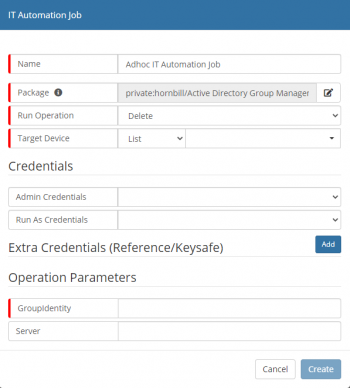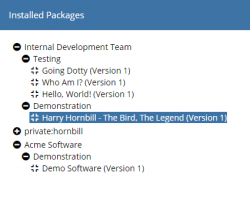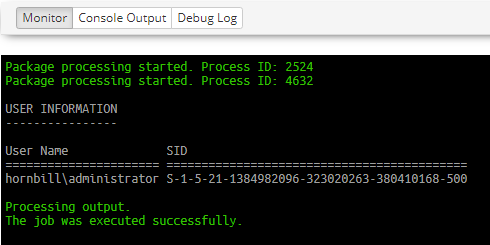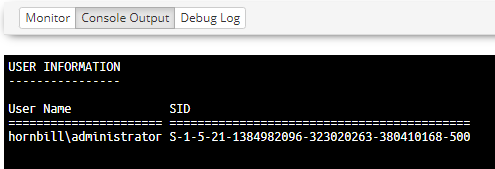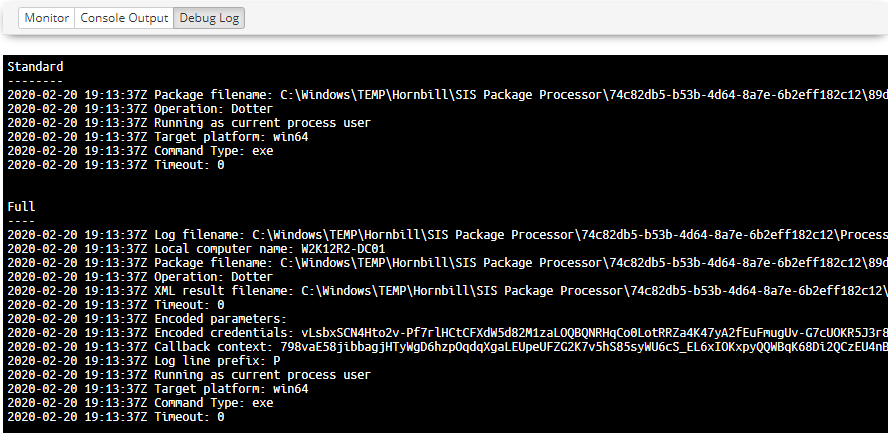Difference between revisions of "IT Automation Job"
| Line 17: | Line 17: | ||
|} | |} | ||
| − | == | + | ==IT Automation Job Properties== |
| − | + | [[File:JobQueueAutomationJobPkg.png|right|350px|link=https://wiki.hornbill.com/images/2/28/JobQueueAutomationJobPkg.png|ITOM IT Automation Job Properties]] | |
| − | + | * Name - the name provided to identify the IT Automation Job | |
| − | |||
| − | [[File: | ||
| − | |||
| − | * Name - name | ||
* Package - the package in which the operation is stored | * Package - the package in which the operation is stored | ||
*:[[Image:JobQueueAutoJobPackageList.png|250px]] | *:[[Image:JobQueueAutoJobPackageList.png|250px]] | ||
| Line 34: | Line 30: | ||
* Extra Credentials - one is able to add other credentials which might be used as part of the functionality within the package | * Extra Credentials - one is able to add other credentials which might be used as part of the functionality within the package | ||
* Package Parameters - INPUT parameters of the selected package; mandatory fields are highlighted; hints might be given in the field box. | * Package Parameters - INPUT parameters of the selected package; mandatory fields are highlighted; hints might be given in the field box. | ||
| + | |||
== Job Information == | == Job Information == | ||
Once the job has been created, the details will be displayed, showing information relating to the job, from here it is also able to view the status of the job and monitor its progress within the Monitor frame. | Once the job has been created, the details will be displayed, showing information relating to the job, from here it is also able to view the status of the job and monitor its progress within the Monitor frame. | ||
Revision as of 07:54, 25 March 2020
IntroductionIT Automation jobs are executed on Managed Devices from within the ITOM Inventory, on a ad-hoc basis. These Jobs can be executed on individual devices or a list of devices from pre-configured Inventory Lists. Published and uploaded packages are used to provide the automation payload which are managed via the ITOM Package Library. Depending on the package used Credentials and Package Parameters will need to be configured, these details will be provided via the Package documentation. |
Related Articles |
IT Automation Job Properties
- Name - the name provided to identify the IT Automation Job
- Package - the package in which the operation is stored
- Run Operation - which operation to perform using the package
- Site Target [Group / Server ] - whether the Job needs to run on all the machines in the SIS Group or on a single SIS/Managed CI
- Target Machine [List / Inventory / Manual] -
- Credentials
- Admin Credentials - Keystore entry
- Run As Credentials - Keystore entry
- Extra Credentials - one is able to add other credentials which might be used as part of the functionality within the package
- Package Parameters - INPUT parameters of the selected package; mandatory fields are highlighted; hints might be given in the field box.
Job Information
Once the job has been created, the details will be displayed, showing information relating to the job, from here it is also able to view the status of the job and monitor its progress within the Monitor frame.
- Summary
- Shows the current status of the job and its name along with who created it and when.
- Target Information
- Provides details of the SIS server that will facilitate the job, target machine and the security keys used.
S server where the is executed
- Execution Details
- The execution details show when the job was started and completed along with any result code.
Dependent on which type of job was executed there will be:
- Package Details (IT Automation)
- Displays details of the deployment package, configured operation along with any arguments that were specified and job timeout limit.
or:
- Discovery Options (Discovery)
- Displays details of the options used by the discovery process, this will differ depending on the discovery mode that is being used.
Monitor
The Monitor frame provides information relating to the execution of the job, the details shown will be dependant on the type of discovery or package that is being been executed.
The above example shows that the process has started and provides an id, which can be used to identify the task executing the package on the target machine. Depending on the package configuration, the monitor will specify more than the process ID. In the above case, the package is configured to execute an executable program as a specific user, using the "Run As Credentials". The first ID is for the process that triggers the package execution, which triggers another process to run an executable using the provided credentials.
All console output from the process will be displayed after this and will dependant on the package contents and configuration. Once the job has completed if there are any output parameters they are processed and displayed, and confirmation of the job successful completion or failure will be output.
Once the job has completed the Console Output and Debug Log frames will become enabled. The Console Output provides a view of only the console output, including any error messages.
In cases where the package may have failed any error messages that are displayed to the console will be visible here, however, this is may not always be the case and is dependant on the package. In these cases and where further details are required the Debug Log can be used to review more technical details.
The Debug Log frame provides two levels of output "Standard" and "Full". Standard logging provides basic output such as the package details, argument, and command details. Full logging provides further details such as the location of log files, the target computer, encoded parameters, and credentials. The exact content will depend on the package being deployed and its configuration.
Cancel / Aborting this Job
Where it is required for a Job to be Cancelled, for example; maybe the job has stalled or is taking a large amount of time and resources. Two options are available via the Cancel and Abort buttons, although their purpose of the two is to kill a process running on a target computer, their methods are different. In most cases just Cancelling a job should suffice, however in cases where this option fails, Abort can be used to force the termination of the Job.
When a job is cancelled its process will be sent a close message, therefore, allowing the process to close itself and all child processes in an orderly fashion. Aborting a Job causes the Job to be forcefully terminated immediately possibly causing child processes to be orphaned, and should only be used as a last resort.
